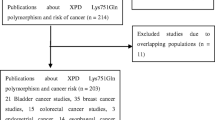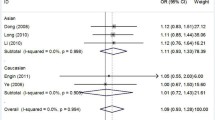Abstract
Published data on the association between Xeroderma Pigmentosum complementation group D (XPD) Lys751Gln polymorphism and breast cancer risk are inconclusive. To derive a more precise estimation of the relationship, a meta-analysis was performed. Crude ORs with 95% CIs were used to assess the strength of association between them. A total of 30 studies including 14,283 cases and 14,426 controls were involved in this meta-analysis. Overall, significantly elevated breast cancer risk was associated with XPD 751Gln allele when all studies were pooled into the meta-analysis (Lys/Gln vs. Lys/Lys: OR = 1.13, 95% CI = 1.02–1.25; Gln/Gln vs. Lys/Lys: OR = 1.21, 95% CI = 1.06–1.38; dominant model: OR = 1.16, 95% CI = 1.05–1.29; and recessive model: OR = 1.14, 95% CI = 1.02–1.27). In the subgroup analysis by ethnicity, borderline significantly increased risks were found for Caucasians (Lys/Gln vs. Lys/Lys: OR = 1.09, 95% CI = 0.98–1.22; dominant model: OR = 1.10, 95% CI = 0.99–1.22) and significantly increased risks were found for Africans in dominant model (OR = 1.10, 95% CI = 1.04–1.15). When stratified by study design, statistically significantly elevated risk was found in population-based studies (Lys/Gln vs. Lys/Lys: OR = 1.10, 95% CI = 1.01–1.20; Gln/Gln vs. Lys/Lys: OR = 1.15, 95% CI = 1.01–1.31; dominant model: OR = 1.12, 95% CI = 1.03–1.23). In conclusion, this meta-analysis suggests that the XPD 751Gln allele is a low-penetrant risk factor for developing breast cancer.

Similar content being viewed by others
References
Parkin DM, Bray F, Ferlay J, Pisani P (2005) Global cancer statistics 2002. CA Cancer J Clin 55:74–108
Lichtenstein P, Holm NV, Verkasalo PK (2000) Environmental and heritable factors in the causation of cancer. N Engl J Med 343:78–85
Flejter WL, McDaniel LD, Johns DR (1992) Correction of xeroderma pigmentosum complementation group D mutant cell phenotypes by chromosome and gene transfer: involvement of the human ERCC2 DNA repair gene. Proc Natl Acad Sci USA 89:261–265
Clarkson SG, Wood RD (2005) Polymorphisms in the human XPD (ERCC2) gene, DNA repair capacity and cancer susceptibility: an appraisal. DNA Repair 4:1068–1074
Justenhoven C, Hamann U, Pesch B (2004) ERCC2 genotypes and a corresponding haplotype are linked with breast cancer risk in a German population. Cancer Epidemiol Biomarkers Prev 13:2059–2064
Shen MR, Jones IM, Mohrenweiser H (1998) Non-conservative amino acid substitution variants exist at polymorphic frequency in DNA repair genes in healthy humans. Cancer Res 58:604–608
Tang D, Cho S, Rundle A, Chen S, Phillips D, Zhou J, Hsu Y, Schnabel F, Estabrook A, Perera FP (2002) Polymorphisms in the DNA repair enzyme XPD are associated with increased levels of PAH-DNA adducts in a case-control study of breast cancer. Breast Cancer Res Treat 75:159–166
Brewster AM, Alberg AJ, Strickland PT, Hoffman SC, Helzlsouer K (2004) XPD polymorphism and risk of subsequent cancer in individuals with nonmelanoma skin cancer. Cancer Epidemiol Biomark Prev 13:1271–1275
Forsti A, Angelini S, Festa F, Sanyal S, Zhang Z, Grzybowska E, Pamula J, Pekala W, Zientek H, Hemminki K, Kumar R (2004) Single nucleotide polymorphisms in breast cancer. Oncol Rep 11:917–922
Justenhoven C, Hamann U, Pesch B, Harth V, Rabstein S, Baisch C, Vollmert C, Illig T, Ko YD, Brüning T, Brauch H (2004) ERCC2 genotypes and a corresponding haplotype are linked with breast cancer risk in a German population. Cancer Epidemiol Biomark Prev 13:2059–2064
Shi Q, Wang LE, Bondy ML, Brewster A, Singletary SE, Wei Q (2004) Reduced DNA repair of benzo[a]pyrene diol epoxide-induced adducts and common XPD polymorphisms in breast cancer patients. Carcinogenesis 25:1695–1700
Terry MB, Gammon MD, Zhang FF, Eng SM, Sagiv SK, Paykin AB, Wang Q, Hayes S, Teitelbaum SL, Neugut AI, Santella RM (2004) Polymorphism in the DNA repair gene XPD, polycyclic aromatic hydrocarbon-DNA adducts, cigarette smoking, and breast cancer risk. Cancer Epidemiol Biomark Prev 13:2053–2058
Dufloth RM, Costa S, Schmitt F, Zeferino LC (2005) DNA repair gene polymorphisms and susceptibility to familial breast cancer in a group of patients from Campinas, Brazil. Genet Mol Res 4:771–782
Kuschel B, Chenevix-Trench G, Spurdle AB, Chen X, Hopper JL, Giles GG (2005) Common polymorphisms in ERCC2 (Xeroderma pigmentosum D) are not associated with breast cancer risk. Cancer Epidemiol Biomark Prev 14:1828–1831
Metsola K, Kataja V, Sillanp P, Siivola P, Heikinheimo L, Eskelinen M, Kosma VM, Uusitupa M, Hirvonen A (2005) XRCC1 and XPD genetic polymorphisms, smoking and breast cancer risk in a Finnish case-control study. Breast Cancer Res 7:R987–R997
Zhang L, Zhang Z, Yan W (2005) Single nucleotide polymorphisms for DNA repair genes in breast cancer patients. Clin Chim Acta 359:150–155
Brewster AM, Jorgensen TJ, Ruczinski I, Huang HY, Hoffman S, Thuita L, Newschaffer C, Lunn RM, Bell D, Helzlsouer KJ (2006) Polymorphisms of the DNA repair genes XPD (Lys751Gln) and XRCC1 (Arg399Gln and Arg194Trp): relationship to breast cancer risk and familial predisposition to breast cancer. Breast Cancer Res Treat 95:73–80
Debniak T, Scott RJ, Huzarski T, Byrski T, Masoj B, van de Wetering T (2006) XPD common variants and their association with melanoma and breast cancer risk. Breast Cancer Res Treat 98:209–215
Mechanic LE, Millikan RC, Player J, de Cotret AR, Winkel S, Worley K (2006) Polymorphisms in nucleotide excision repair genes, smoking and breast cancer in African Americans and whites: a population-based case–control study. Carcinogenesis 27:1377–1385
Onay VU, Briollais L, Knight JA, Shi E, Wang Y, Wells S, Li H, Rajendram I, Andrulis IL, Ozcelik H (2006) SNP–SNP interactions in breast cancer susceptibility. BMC Cancer 6:114
Shen J, Desai M, Agrawal M, Kennedy DO, Senie RT, Santella RM, Terry MB (2006) Polymorphisms in nucleotide excision repair genes and DNA repair capacity phenotype in sisters discordant for breast cancer. Cancer Epidemiol Biomark Prev 15:1614–1619
Costa S, Pinto D, Pereira D, Rodrigues H, Cameselle-Teijeiro J, Medeiros R, Schmitt F (2007) DNA repair polymorphisms might contribute differentially on familial and sporadic breast cancer susceptibility: a study on a Portuguese population. Breast Cancer Res Treat 103:209–217
Romanowicz-Makowska H, Sobczuk A, Smolarz B, Fiks T, Kulig A (2007) XPD Lys751Gln polymorphism analysis in women with sporadic breast cancer. Pol J Pathol 58:245–249
Bernard-Gallon D, Bosviel R, Delort L, Fontana L, Chamoux A, Rabiau N, Kwiatkowski F, Chalabi N, Satih S, Bignon YJ (2008) DNA repair gene ERCC2 polymorphisms and associations with breast and ovarian cancer risk. Mol Cancer 7:36
Kipikasová L, Wolaschka T, Bohus P, Baumohlová H, Bober J, Blazejová J (2008) Polymorphisms of the XRCC1 and XPD genes and breast cancer risk: a case–control study. Pathol Oncol Res 14:131–135
Li J, Jin W, Chen Y, Di G, Wu J, Shao ZM (2008) Genetic polymorphisms in the DNA repair enzyme ERCC2 and breast tumour risk in a Chinese population. J Int Med Res 36:479–488
Rajaraman P, Bhatti P, Doody MM, Simon SL, Weinstock RM, Linet MS (2008) Nucleotide excision repair polymorphisms may modify ionizing radiation-related breast cancer risk in US radiologic technologists. Int J Cancer 123:2713–2716
Shore RE, Zeleniuch-Jacquotte A, Currie D, Mohrenweiser H, Afanasyeva Y, Koenig KL, Arslan AA, Toniolo P, Wirgin I (2008) Polymorphisms in XPC and ERCC2 genes, smoking and breast cancer risk. Int J Cancer 122:2101–2105
Smith TR, Levine EA, Freimanis RI, Akman SA, Allen GO, Hoang KN, Liu-Mares W, Hu JJ (2008) Polygenic model of DNA repair genetic polymorphisms in human breast cancer risk. Carcinogenesis 29:2132–2138
Synowiec E, Stefanska J, Morawiec Z, Blasiak J, Wozniak K (2008) Association between DNA damage, DNA repair genes variability and clinical characteristics in breast cancer patients. Mutat Res 648:65–72
Hsu MS, Yu JC, Wang HW, Chen ST, Hsiung CN, Ding SL, Wu PE, Shen CY, Cheng CW (2009) Synergistic effects of polymorphisms in dna repair genes and endogenous estrogen exposure on female breast cancer risk. Ann Surg Oncol. doi:10.1245/s10434-009-0802-0
Mitra AK, Singh N, Garg VK, Chaturvedi R, Sharma M, Rath SK (2009) Statistically significant association of the single nucleotide polymorphism (SNP) rs13181 (ERCC2) with predisposition to Squamous Cell Carcinomas of the Head and Neck (SCCHN) and Breast cancer in the north Indian population. J Exp Clin Cancer Res 28:104
Syamala VS, Syamala V, Sreedharan H, Raveendran PB, Kuttan R, Ankathil R (2009) Contribution of XPD (Lys751Gln) and XRCC1 (Arg399Gln) polymorphisms in familial and sporadic breast cancer predisposition and survival: an Indian report. Pathol Oncol Res 15:389–397
Jakubowska A, Gronwald J, Menkiszak J, Górski B, Huzarski T, Byrski T (2010) BRCA1-associated breast and ovarian cancer risks in Poland: no association with commonly studied polymorphisms. Breast Cancer Res Treat 119:201–211
Cochran WG (1954) The combination of estimates from different experiments. Biometrics 10:101–129
Mantel N, Haenszel W (1959) Statistical aspects of the analysis of data from retrospective studies of disease. J Natl Cancer Inst 22:719–748
DerSimonian R, Laird N (1986) Meta-analysis in clinical trials. Control Clin Trials 7:177–188
Tobias A (1999) Assessing the influence of a single study in the meta-analysis estimate. Stata Tech Bull 8:15–17
Egger M, Davey Smith G, Schneider M, Minder C (1997) Bias in meta-analysis detected by a simple, graphical test. BMJ 315:629–634
Taylor SJ, Tweedie RI (1998) Practical estimates of the effect of publication bias in meta-analysis. Australas Epidemiol 5:14–17
Cleaver JE (2000) Common pathways for ultraviolet skin carcinogenesis in the repair and replication defective groups of xeroderma pigmentosum. J Dermatol Sci 23:1–11
Coin F, Marinoni JC, Rodolfo C (1998) Mutations in the XPD helicase gene result in XP and TTD phenotypes, preventing interaction between XPD and the p44 subunit of TFIIH. Nat Genet 20:184–188
Au WW, Navasumrit P, Ruchirawat M (2004) Use of biomarkers to characterize functions of polymorphic DNA repair genotypes. Int J Hyg Environ Health 207:301–313
Vodicka P, Kumar R, Stetina R (2004) Genetic polymorphisms in DNA repair genes and possible links with DNA repair rates, chromosomal aberrations and single-strand breaks in DNA. Carcinogenesis 25:757–763
Pavanello S, Pulliero A, Siwinska E (2005) Reduced nucleotide excision repair and GSTM1-null genotypes influence anti-β [α] PDE-DNA adduct levels in mononuclear white blood cells of highly PAH-exposed coke oven workers. Carcinogenesis 26:169–175
Hirschhorn JN, Lohmueller K, Byrne E (2002) A comprehensive review of genetic association studies. Genet Med 4:45–61
Wacholder S, Chanock S, Garcia-Closas M (2004) Assessing the probability that a positive report is false: an approach for molecular epidemiology studies. J Natl Cancer Inst 96:434–442
Author information
Authors and Affiliations
Corresponding authors
Rights and permissions
About this article
Cite this article
Qiu, LX., Yao, L., Zhang, J. et al. XPD Lys751Gln polymorphism and breast cancer susceptibility: a meta-analysis involving 28,709 subjects. Breast Cancer Res Treat 124, 229–235 (2010). https://doi.org/10.1007/s10549-010-0813-3
Received:
Accepted:
Published:
Issue Date:
DOI: https://doi.org/10.1007/s10549-010-0813-3




